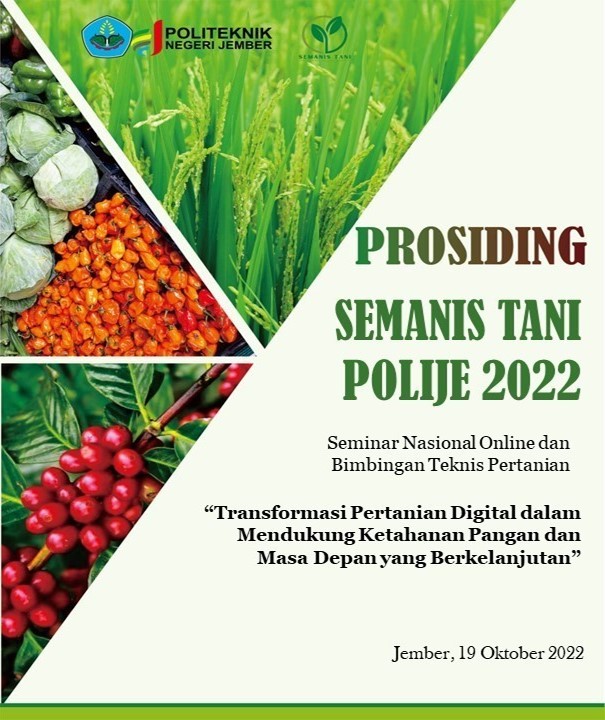Efektivitas Proporsi Bunga Dan Pembuangan Mahkota Bunga Betina Terhadap Produksi Benih Mentimun Jepang Di Dalam Greenhouse
DOI:
https://doi.org/10.25047/agropross.2022.264Kata Kunci:
Japanese Cucumber Seed Production; , Flower Proportion; , Female Flower Petals Plucking;Abstrak
Japanese cucumber or Kyuri is a highly demanded agricultural product because of its high economic value and unique characteristics compared to local cucumbers. One of the methods to increase the production of Japanese cucumber seed is by improving the cultivation techniques of the seed producers. Some of those cultivation techniques are flower proportion and female flower petals castration. This study aimed to determine the effectiveness of flower proportion and female flower petals castration on the production of Japanese cucumber seed in greenhouses. This study used a factorial CRD (Completely Randomized Design) method by employing two treatments, namely the flower proportion P1 (1♂ : 2♀), P2 (1♂ : 1♀), and P3 (2♂ : 1♀); and female flower petals plucking K1 (without petal) and K2 (with petal). Each of these treatments was repeated four times. The results showed no interaction between the treatment of flower proportions (P) and female flower petals castration (K). The proportion treatment of P3 showed very significantly different results in the parameters of the seed numbers of each plant (784,14), the number of pithy seeds of each plant (460,42), and pithy seeds weight of each plant (11,13 gram); and not significantly different results in the parameters of the number of harvested fruit from each plant, fruit length, fruit diameter, and 1000-seed weight. The female flower petals plucking treatment (K1) showed significantly different results in the parameter of seeds number in each plant (385,22), and not significantly different results in the parameters of the fruit number of each plant, fruit length, fruit diameter, seed number of each plant, pithy seeds weight.
Unduhan
Referensi
Ahyar, Y. 2018. “Peningkatan Produktivitas Tanah Kering Masam untuk Pertumbuhan dan Hasil Tanaman Mentimun Jepang (Cucumis sativus L.) dengan Pemberian Tepung Rajungan dan Fungi Mikoriza Arbuskula”. Doctoral Dissertation, UIN Sunan Gunung Djati Bandung. http://digilib.uinsgd.ac.id/id/eprint/18388. [14 Maret 2021]
Akihima, T. And M. Omura. 1986. Preservation of fruit tree pollen. P. 101-112. In: Y. P. S. Bajaj (ed.). Bioteknology in agricultur and forestry. Vol. I Springer-Verlag.
Arief, R., E. Syam’un, dan S. Saenong. 200 Syam’un, dan S. Saenong. 2004. Evaluasi Mutu Fisik dan Fisiologis Benih Jagung cv Lamaru Dari Ukuran Biji dan Umur yang Berbeda. Jurnal Sains dan Teknologi 4 (2): 54-64. https://scholar.google.com/scholar?hl=en&as_sdt=0,5&cluster=6638014329941818192 [21 Desember 2020]
Badan Pusat Stastistik. 2018. “Data Produksi Mentimun di Indonesia periode 2015- 2018”. Jakarta. www.hortikultura2.pertanian.go.id [30 Agustus 2020].
Birnadi, S. 2017. “Respons Mentimun Jepang (Cucumis sativus L.) Var. Roberto terhadap Perendaman Benih dengan Giberelin (GA3) dan Bahan Organik Hasil Fermentasi (BOHASI)”. Dalam Jurnal ISTEK 10(2):77-90. Bandung : Fakultas Sains dan Teknologi. http://journal.uinsgd.ac.id/index.php/istek/article/view/1479. [14 Maret 2021]
Bjorkman, T. 1995. The Effect of Pollen Load and Pollen Grain Competition on Fertilization Success And Progeny Performance in Fagopyrum Esculentum. In Euphytica 83: 47-52. New York: Cornell University. https://doi.org/10.1007/BF01677860 [01 Desember 2020]
Deden, A. 2008. Biologi Kelompok Pertanian. https://www.books. google. [21 Desember 2020]
Hasanuddin. 2013. “Penentuan Viabilitas Pollen dan Reseptif Stigma Pada Melon (Cucumis melo L) serta Hubungannya dengan Penyerbukan dan Produksi Buah”. Dosen Program Studi Pendidikan Biologi FKIP. Banda Aceh. http://e-repository.unsyiah.ac.id/JBE/article/view/411. [01 Desember 2020]
Kelly, J. K., A. Rasch, and S. Kalisz. 2002. A Method to Estimate Pollen Viability from Pollen Size Variation. American Journal of Botany. 89:1021-1023. America. https://doi.org/10.3732/ajb.89.6.1021 [14 Januari 2020]
Keputusan Menteri Pertanian 2017. Sertifikasi Benih Tanaman Buah, Sayuran Tahunan, Tanaman Obat Tahunan. https://docplayer.info/89398437-Sertifikasi-benih-tanaman-buah-sayuran-tahunan-dan-tanaman-obat-tahunan-i-pendahuluan.html [30 Desember 2020].
Kusnadi, M.H. 2000. Kamus Istilah Pertanian. Karnisius. Yogyakarta.
Laksono, R.A. 2020. Pengujian Efektivitas Jenis Media Tanam dan Nutrisi Terhadap Produksi Kubis Bunga (Brassicaoleracea L. var. Botrytis ,subvar .Cauliflora DC) Kultivar Mona F1 pada Sistem Hidroponik. Kultivasi, 19(1): 1030-1039.time. https://jurnal.unpad.ac.id/kultivasi/article/view/23744. [16 Desember 2020]
“Mahkota Bunga”.Wikipedia.Ensiklopedia Gratis.Wikipedia. Ensiklopedia Gratis 04 Agustus 2021 Web. 04 Agustus 2021. https://id.wikipedia.org/wiki/Mahkota_bunga.
Putri, K.P., & Pramono, A. A.(2013).Perkembangan Bunga dan Keberhasilan Reproduksi Jenis Saga (Adenanthera pavoninaL.).Penelitian HutanTanaman,10(3), 147–154.
Rahmawati, S. 2010. Produksi Benih Tanaman Pare (Momordica charantia L.) Unggul di Multi Global Agrindo Karangpandan. Karanganyar. Dalam Tugas Akhir. Surakarta: Universitas Sebeleas Maret.
Rahmi, Yusvita Maulidia, Sri Lestari Purnamaningsih dan Sumeru Ashari. 2015. Tingkat viabilitas benih mentimun (Cucumis sativus L.) hasil penyerbukan. Jurnal Produksi Tanaman. 3(1):50-55. http://protan.studentjournal.ub.ac.id/index.php/protan/article/view/168 [30 Desember 2020].
Rukmana, Rahmat. 1994. Budidaya Mentimun. Yogyakarta: Kanisius.
Sari, Ni.K.Y., Permatasari A.A., Deswiniyanti, N.W. 2019. PKM Hidroponik Kelompok Guru dan Siswa SMKN 1 Petang, Badung. Jurnal Paradharma, (30):48-51
Sukarmin, 2009. Teknik Penyerbukan pada Tanaman Sirsak. Buletin Teknik Pertanian. 14(1):9-11. Bogor. http://protan.studentjournal.ub.ac.id/index.php/protan/article/view/242 [16 Desember 2020]
Suketi, Ketty. 2013. Studi Morfologi Bunga, Penyerbukan Dan Perkembangan Buah Sebagai Dasar Pengendalian Mutu Buah Pepaya Ipb. Disertasi. IPB. https://repository.ipb.ac.id/handle/123456789/51584. [22 Desember 2020]
Sumpena, U. 2001. Budidaya Mentimun Intensif dengan Mulsa secara Tumpang Gilir. Jakarta: Penebar Swadaya.
Sumpena, Uun. 2008. Budidaya Mentimun Intensif, Dengan Mulsa, Secara Tumpang Sari. Jakarta: Penebar Swadaya.
Susila, A. D. 2013. Sistem Hidroponik. Departemen Agonomi dan Hortikultura. Fakultas Pertanian. Modul. Bogor: IPB. 20 hal.
Syukur M., S. Sujiprihati & R. Yunianti. 2015. Teknik Pemuliaan Tanaman. Jakarta : Penebar Swadaya.
Widiastuti, A. 2008. “Pollen Viability and Its Effect on Fruit Set of Oil Plam (Elaeis guineensis Jacq.)”. Dalam Biodiversitas, Journal of Biological Diversity.9:35 -38. Bogor: Institut Pertanian Bogor. https://smujo.id/biodiv/article/view/411. [20 Desember 2020]
Wang Y. Q., D. X. Zhang and, Z. Y. Chen. 2004. Pollen histochemistry and pollen : ovul ratios in zingiberaceae. London. In Annals Botany. 94: 583 – 591. https://doi.org/10.1093/aob/mch177. [22 Desember 2020]
Wijaya, S. A., N. Basuki, dan S. L. Purnamaningsih. 2015. Pengaruh Waktu Penyerbukan dan Proporsi Bunga Betina dengan Bunga Jantan terhadap Hasil dan Kualitas Benih Mentimun (Cucumis sativus L) Hibrida. Produksi Tanaman, 3(8):615-622. https://repository.ipb.ac.id/handle/123456789/51584 [20 Desember 2020]
Unduhan
Diterbitkan
Cara Mengutip
Terbitan
Bagian
Lisensi
Hak Cipta (c) 2022 Indah Permatasari , Leli Kurniasari

Artikel ini berlisensi Creative Commons Attribution 4.0 International License.
Hak cipta (Copyright) artikel yang dipublikasikan di Agropross : National Conference Proceedings of Agriculture dipegang oleh penulis (Copyright by Authors) di bawah Creative Commons Attribution 4.0 International License (CC-BY). Sehingga penulis tidak memerlukan perjanjian pengalihan hak cipta yang harus diserahkan kepada redaksi.






